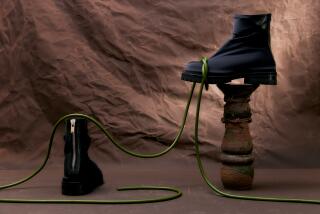Fashion 88 : All That Glitters Is Not Gold, but Most Is
- Share via
In this corner, the sapphire pendant as big as a Brazil nut, with the $75,000 price tag. Over there-- past the women in the minks wearing the running shoes and the grandfathers rocking the baby carriages--fake onyx earrings for $40. And in between there’s Haskell Faber, with the high-gloss manicure and the gold pinkie ring, just back from a card game at the Friar’s Club.
Faber is inspecting things in his Beverly Hills “real jewelry” store with the wall-to-wall plush carpets. It’s called XIV Karats Ltd. and it’s as crowded as a deli takeout counter at lunchtime. You would think he was giving away the gold.
“On a slow day, a hundred people come through here,” he says. “Christmastime we had 700 or 800 a day.” He can explain that. What you pay for his jewelry is half what you read on the price tag.
Changed Locations
Some would say Faber made a bold move when he took his downtown business to the west side of town. He uprooted himself from the corner of 9th and Main streets after 14 years in the heart of the cut-rate district. But he kept things the same when he took his store to Beverly Drive in Beverly Hills.
Strolling the wide aisles between the jewelry cases, Faber keeps an eye on the action. Actress Lisa Eilbacher, walks in and he doesn’t miss a beat.
“We get the Lakers in here, the Dodgers, the movie industry. I don’t like to name names,” he says. One of his children, both of whom work in the shop, mentions Wayne Newton.
Eilbacher is wearing skintight black jeans, Porsche sunglasses and a wide, wide paved diamond band. She wants to know about the wedding ring she has on order.
“It’s the other diamond, the big one that goes on top of this,” she says, flashing her engagement band again.
Next, Eilbacher slips a small jewelry sack from her shoulder bag. “I need you to copy this earring,” she says, pouring one dome-shape cluster of pearls onto the counter. The match to it is lost.
Faber explains that a lot of his business is custom work, and he duplicates a lot of jewelry. “People even bring magazine pictures and we make it for them.”
From the same big bag, Eilbacher pulls a diamond-and-sapphire necklace with a pair of matching earrings. They’re at least 35 years old, and they could use a few more diamonds, she says.
Faber explains why.
“Generally the older cut stones don’t shine and reflect like the new. Technology’s advanced since then.”
In his dark, paneled office, he can relax behind the big desk. It’s quieter there, but he hears the soft buzz of tiny electric tools coming from an open work space at the back of the store. Nine jewelers, a polisher, a pearl stringer, an engraver and a watch repairer are handling the special orders. The workers are all from other countries.
Expensive Classics
Faber says he moved from New York to California in 1936 to sell watches and diamonds directly to stores. He never really got serious about the costume jewelry business, although he does keep one counter of it in his shop. He would rather stock moderate-priced versions of some instantly recognizable, very expensive classics--three-band rolling rings and X-shape earrings among them.
A lot of the “inspired by” stock comes from factories that supply big-name jewelry houses and also make similar models using lower-quality gold, he says. “So we can buy things in the same style.”
Most of the gold jewelry in his store comes from Italy, most of the pearls come from Japan. The loose, semiprecious stones he buys are from Burma and Ceylon (Sri Lanka), he explains.
Imitations of big-name jewelry designs don’t bother him as long as they’re made of real gold and stones.
“A cubic zirconium looks as good as a diamond the day it goes out of the shop,” he says. “But the older it gets, the more it looks like a piece of glass.”
Despite the deals at XIV Karats--”short markups,” Faber calls them--he says he can afford to open more shops, but he would rather keep everything under one roof. And he’ll tell you why.
“I’m here every day, not running from store to store, and that’s what makes a business work. I don’t want more money, I just want more customers.”
He can’t quite explain the difference.






